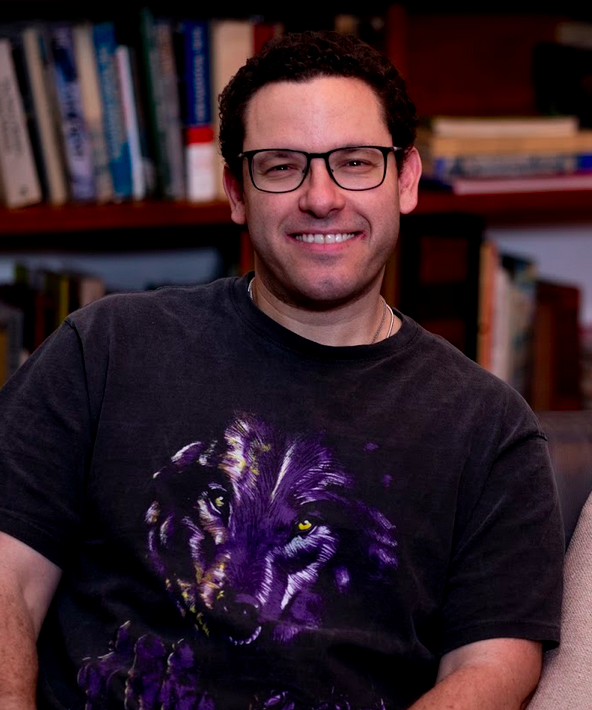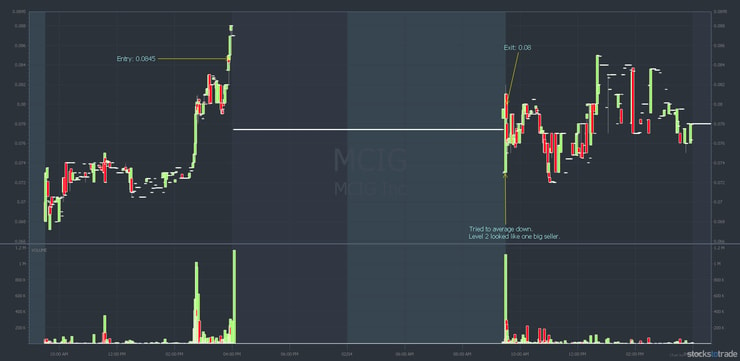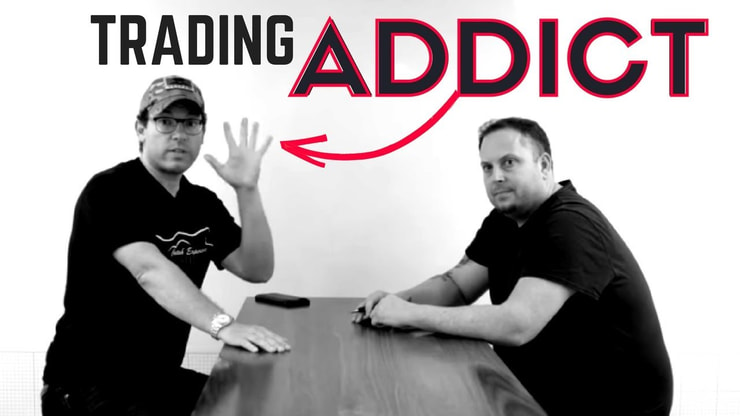In this edition, I’ll explore overtrading, a weird gap-down, and Tesla’s big week. Plus, I travel to Japan as Karmagawa goes high fashion.
Why focus on overtrading? I mentioned it in a recent video lesson. Then a student asked me about it. (See the question below.)
Get access to over 6,000 video lessons with a PennyStocking Silver subscription.
My goal is to prevent you from falling into the overtrading trap. It’s a slippery slope that can lead to stock market addiction. You’re here to develop trading skills to gain freedom. NOT to chain yourself to a computer screen eight hours a day … or more.
More about overtrading later.
First, a little about my recent travels…
Table of Contents
- 1 Charity, Trading, and Sushi in Japan
- 2 Trading Lesson of the Week: The TSLA Short Squeeze
- 3 Trading Questions From Students
- 4 How to Avoid Overtrading
- 5 Millionaire Mentor Market Wrap
- 6 Trading Challenge
- 7 What Students Are Saying
Charity, Trading, and Sushi in Japan

2025 Millionaire Media, LLCThis week I’m checking in from Japan. I flew from Miami to Tokyo to meet with several fashion designers. We’re taking our upcoming Karmagawa gear beyond basic. We’re not just doing basic branded stuff like some wannabe charity brands. We’re going high fashion.
So it’s pretty crazy the people — the designers and celebrities — I’m meeting. But it’s a process and takes time, which is why I’m here in Tokyo.
Trading in this time zone isn’t my favorite. But it’s not too bad because I get to eat good sushi, too.
I’ve been getting some questions about traveling during the coronavirus outbreak. Am I concerned about travel?
Japan has one of the highest numbers of confirmed coronavirus cases. There are 26 cases and it will likely go up every day.
But there’s also a quarantined cruise ship, the Diamond Princess, docked in Yokohama. That’s only about 17 miles away from Tokyo. Earlier today (February 10), TBS news reported a total of 130 confirmed cases on the ship. It’s the highest concentration outside mainland China.
I’m tracking numbers with this web page by Johns Hopkins CSSE.
Some media reports show Japan’s number of confirmed cases much higher. That’s because they’ve included the sick cruise ship passengers. It’s kinda deceiving. That said, they are taking infected passengers off the ship to the hospital. So I guess you could say they’re now in Japan.
But if you think about it … 45, 60, even 150 in a country with 127 million people … that’s very low.
The coronavirus is scary, for sure. And I’m not going to China. You might already know there’s a travel ban for China. But I wouldn’t go now anyway.
Also, roughly 80% of the people dying are over 60 years old. More than 75% have pre-existing conditions.
One more thing…
… when I travel like this, I’m pretty careful. I’m not saying, “Hey, I’ll take the subway and mingle with millions of people all at once.”
I usually sit in my hotel room, have meetings, and go out for dinner. So I don’t take excessive risks. Especially in Japan because I’m working in the middle of the night. I’m not even that much fun here…
Now it’s time for the…
Trading Lesson of the Week: The TSLA Short Squeeze

2025 Millionaire Media, LLCI’ll get to the question about overtrading in a moment. First, the biggest lesson from the market this week came from Tesla.
It was so crazy I wrote an entire post about how Tesla was trading like a penny stock.
Mark Croock and Tim Grittani were all about shorting it in the $930 to $950 area. And I saw it going up … and up…
Here’s a small part of my back and forth with Grittani on February 4…
09:40 AM timothysykes → kroyrunner: $TSLA can go to $2,000 or even $5,000, big difference between shorting pump and dumps, just don’t want to see your profit go from $9.6 million to -$30-50 million, it can happen, I’ve seen it with too many traders.
09:41 AM kroyrunner → timothysykes: as long as i cut losses nothing to worry about. and trade i take will be HOD risk as usual and will eat it immediately if wrong. but i agree can go MUCH higher. hence waiting for acton to confirm first instead of being a dumbass saying “it’s up too much!”
My thinking was “Whoa. Calm down, stick to penny stocks.” And that’s based on my trying to protect my students with less experience.
09:41 AM RocUWorld: this is real learning from real teachers… thank you both.
Tesla Finally Falls
So TSLA kept uptrending on February 4. Then, in the last 15 minutes of the trading day, it dropped from $963 to $860 before closing at $887. The next day an analyst downgraded it, and it went down to $700.
So Grittani and Croock were dead on. I don’t know if Grittani made money, but I think he did. Croock made about $25,000.*
+25k on $TSLA is nice but leaving $160k on table is rather disappointing… gotta be very patient on first red day!!!
— Mark Croock (@thehonestcroock) February 5, 2020
So for me, it was all about trying to warn newbies against playing out of their league. But as it turns out, my aggressive students like Croock and Grittani were dead-on right … and…
… a lot of these penny stock strategies do apply to high-priced stocks. But like penny stocks, you have to wait for the best setups.
[*Remember, these are not typical results. These guys put in the time and dedication and have exceptional skills and knowledge. Most traders — 90% — lose money. Always remember trading is risky … never risk more than you can afford.]
More Breaking News
- Northern Dynasty Minerals Stock Rises on Positive EPA Settlement News
- B2Gold Corp’s Unexpected Surge: What’s Driving It?
- Ericsson’s Stock Dynamics: Investigating the Fluctuations
Protecting Students Is a Priority
A warning to newbies and traders with small accounts: Be careful.
I tell newbies to avoid short selling. And I advise against trading high-priced stocks. There’s so much opportunity with penny stocks that you don’t have to trade high-priced stocks. If you wanna trade high-priced stocks, build your account first. Earn your way there.
New to penny stocks? Get my FREE penny stock guide here.
I’m kinda shell-shocked with short selling. I try to protect newbies from squeezes. So I’m not gonna be aggressive like my advanced students. But it was a good lesson for me and a good lesson for everybody.
Now it’s time for…
Trading Questions From Students
The first question is about a first green day OTC runner I bought on a multi-day breakout going into the close. My goal was to make 10%–20% into a morning gap up. Instead, mCig, Inc. (OTCPK: MCIG) gapped down into the February 4 open.
Check it out…
“You tried to average down on MCIG based on ‘too great a gap down’ to a strong support level. Is that a pattern worth learning?”
No. Statistically I should have cut immediately. But it was such a weird one — there was one big seller. I missed trying to dip buy at 7.31 cents after the big gap down from 8.88 cents. That’s a HUGE gap down without negative news.
Check out the MCIG chart from February 3–4:

Again, it looked like one seller. When I looked at Level 2, there wasn’t a trend. (For more on Level 2, watch this guide: Learn Level 2.) And there wasn’t bad news. Plus, the whole market was up. It looked really strange.
This is where nuance comes in…
My thesis was that it was one big seller. If that was the case, I was willing to bend the rules a little bit. Again, this isn’t an exact science. (I trade with these rules.)
As a newbie you probably don’t know what one seller looks like. So, for me, this is 20+ years of trading. It would have been nice if I could’ve averaged down. I could have turned a small loss into a small profit.
“The Complete Penny Stock Course” is a solid foundation for trading penny stocks. Get it. Read it several times.
MCIG didn’t gap up like I wanted, and I couldn’t get filled trying to average down. So I sold around 8 cents for a small loss. It happens. Rule #1: cut losses quickly.
More Than One Way to Trade the MCIG Move
The stock was on my watchlist for a few days at the end of January. I traded MCIG for a $355 profit* on January 29.
[My results are not typical. I’ve developed exceptional knowledge and skills over time. Do your due diligence and never risk money you can’t afford to lose.]
And I wasn’t the only person in chat to trade MCIG on February 3. Here are a few comments from students in the Trading Challenge chat room…
03:24 PM Luke_Fenwick: in and out of MCIG from .079 to .082 9000 shares. 15$ after fees. gotta work on patience and entry. next resistance is .10’s. goodluck jackaroo and everyone else.
Or this solid trade from Profit.ly user therealmcdougal. Way to stick to your plan!
03:57 PM therealmcdougal: and I’m out MCIG .088 from .08, made my 10% so no need to risk holding overnight even though Tim and Jackaroo are! gotta grow my small account, as few risks as possible.
03:58 PM therealmcdougal: just hit my 2nd and 3rd profitable trade in the same day since trading real $. Only $100 profit but playing small positions in this crazy market. Super proud of myself for not chasing and not being greedy.
Jack Kellogg also jumped on the opportunity for a gap up and morning spike…
04:00 PM Jackaroo: swinging full MCIG up $509 there and realized $1.3k on day, good start to the month! See you guys tomorrow!
Jack stayed disciplined cutting losses the next day. Seeing the gap down…
09:26 AM Jackaroo: MCIG wow. low blow.
Jackaroo sold at the open…
09:31 AM Jackaroo: sold MCIG .0741 for a loss.
Finally, the question about overtrading…
“In a recent video lesson you talked about overtrading. Are you overtrading because there are so many plays?”
I was probably overtrading because I was in Miami. There are a lot of plays. But I was also in a good time zone with a pretty clear schedule. This is part of the reason why I travel…
I’m not good when I sit around all day … “Oh, here’s a play. Here’s another play. And here’s another play.”
I’m a classic overtrader myself. That’s one reason I think I’m such a good teacher. In other words, I focus on preventing others from making the same mistake. And, again, this is why I travel so much.
Some people think I should stop traveling and focus on trading. They say, “just stay in one place…”
Statistically, I Do Better When I Travel
That would be wrong for me. Statistically, I do better when I travel. Maybe it’s because I’m jet-lagged or tired. Or because I don’t have great Wi-Fi … or I have a crazy schedule.
No matter how you slice it, it forces me to choose only the best plays. It’s too much of a headache trading from some of the places I visit. Not to mention the strange time zones. But I purposely travel and put myself in weird time zones or bad Wi-Fi situations.
Why? Because it makes it next to impossible to overtrade.
That’s how sick I am with overtrading. But I want you to see that. I never got help. But I haven’t prioritized bettering my trading. Instead, I focus on teaching. I always ask myself, “How can I teach better?”
Check out this video where I interview a student and we talk about overtrading. This is such an important subject. Bookmark this post and watch the first five minutes several times.
How to Avoid Overtrading
As you can see in the video, I’m candid about overtrading and stock market addiction. But I work hard to help my students avoid overtrading.
So I’m kind of a lost cause on the overtrading front. But it’s not the end of the world because I love to travel. It works for me. Whatever you do … don’t overtrade. Here are five tips to help you avoid overtrading.
5 Tips to Avoid Overtrading
Tip #1: Focus on the best setups. Only take trades with a great risk/reward ratio. Again, for me this means putting myself in situations where trading is difficult.
Tip #2: Make a trading plan and stick to it. Build self-discipline from day one.
Tip #3: Recognize the temptation. If you’re trying to talk yourself into a trade, you’re overtrading. Adopt the mentality of a retired trader.
Tip #4: Be willing to walk away. If you feel like you need to trade, it’s a sure sign you’re on the slippery slope.
Tip #5: Keep a trading journal. Be honest and meticulous with your journal entries.
Millionaire Mentor Market Wrap
That’s another update in the books.
I hope you got the message about overtrading. It’s easy to do. Again, it’s a slippery slope. I can’t tell you how many traders I’ve seen churn and burn their accounts all the way to zero.
If you want to trade … you have the wrong mindset. Instead, set a goal to trade well and only wait for the best setups. You can save yourself a lot of trouble.
Trading Challenge
The Trading Challenge is my most comprehensive course. It’s a full-immersion experience. You get access to thousands of hours of archived webinars, 6,000+ video lessons, the Trading Challenge chat room, DVDs, and so much more.
If you’re ready to focus and study harder than ever before, apply for the Trading Challenge now.
What Students Are Saying
Here are a few recent comments from students.
From Twitter
Not a horrible office view. I could think of A LOT better but also A LOT worse. @timothysykes #laptoplifestyle can’t thank you enough for motivation and education. pic.twitter.com/DLVVfAzFSz
— Fletcher96 (@Michelle_F78) February 4, 2020
Good morning Tim, thank you so much for your free lesson on YouTube, it’s really helping me a lot. I took $500, now I am at $5100, still have a lot of studying to do, making lots of mistakes, when I get a few more dollars I want to be your student
— Anthony D Holness (@danteparris) February 7, 2020
From the Trading Challenge and Pennystocking Silver Chat Rooms
CrazyWillows → timothysykes: love your process Tim, thank you and well done on your trade.
KimH → timothysykes: Thank you for all of this. I truly appreciate your time and knowledge in answering our questions. This is tremendously helpful.
RPhTrader→ timothysykes: thank you Tim. You are an awesome teacher.
KDJourney → timothysykes: Thank you > every day is a study day . . . !
sealwgI: don’t tweet, oh Guru of the tickers, but I learn a ton when I trade and watch on days you’re trading, and I’m able to keep up with, and understand where you’re going with your trades. I’m very modestly trading a cash account, and learning to limit losses (a few too many at this time, but I know that will change with experience). Thank you… great trading day.
What do you think about this warning against overtrading? Comment below, I love to hear from all my readers!












Leave a reply